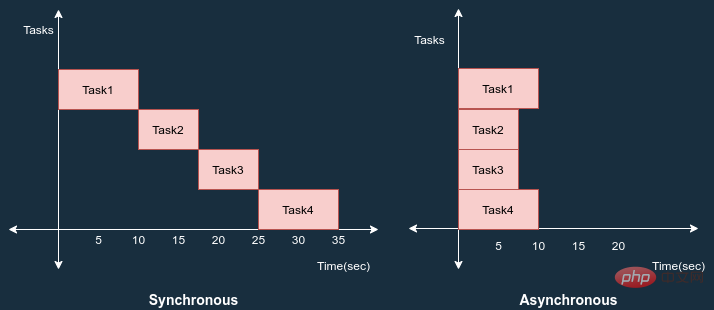SpringBoot怎么优雅地实现异步调用
前言
同步编程:在同步编程中,任务一次执行一个,只有当一个任务完成时,下一个任务才会被解除阻塞。
异步编程:在异步编程中,可以同时执行多个任务。您可以在上一个任务完成之前转到另一个任务。

在Spring Boot中,我们可以使用@Async注解来实现异步行为。
实现步骤
1.定义一个异步服务接口AsyncService.java
public interface AsyncService {
void asyncMethod() throws InterruptedException;
Future<String> futureMethod() throws InterruptedException;
}2.实现定义的接口AsyncServiceImpl.java
@Service
@Slf4j
public class AsyncServiceImpl implements AsyncService {
@Async
@Override
public void asyncMethod() throws InterruptedException {
Thread.sleep(3000);
log.info("Thread: [{}], Calling other service..", Thread.currentThread().getName());
}
@Async
@Override
public Future<String> futureMethod() throws InterruptedException {
Thread.sleep(5000);
log.info("Thread: [{}], Calling other service..", Thread.currentThread().getName());
return new AsyncResult<>("task Done");
}
}AsyncServiceImpl是一个spring管理的bean。您的异步方法必须是公共的,而且是被
@Async注解修饰。返回类型被限制为
void或Future。
3.定义一个控制器AsyncController.java
@EnableAsync
@RestController
@Slf4j
public class AsyncController {
@Autowired
AsyncService asyncService;
@GetMapping("/async")
public String asyncCallerMethod() throws InterruptedException {
long start = System.currentTimeMillis();
log.info("call async method, thread name: [{}]", Thread.currentThread().getName());
asyncService.asyncMethod();
String response = "task completes in :" +
(System.currentTimeMillis() - start) + "milliseconds";
return response;
}
@GetMapping("/asyncFuture")
public String asyncFuture() throws InterruptedException, ExecutionException {
long start = System.currentTimeMillis();
log.info("call async method, thread name: [{}]", Thread.currentThread().getName());
Future<String> future = asyncService.futureMethod();
// 阻塞获取结果
String taskResult = future.get();
String response = taskResult + "task completes in :" +
(System.currentTimeMillis() - start) + "milliseconds";
return response;
}
}关键点,需要添加启用异步的注解
@EnableAsync,当然这个注解加在其他地方也ok得。当外部调用该接口时,
asyncMethod()将由默认任务执行程序创建的另一个线程执行,主线程不需要等待完成异步方法执行。
4.运行一下
现在我们运行一下看看,是不是异步返回的。


可以看到调用/async接口,最终一步调用了方法。


调用/asyncFuture,发现返回5秒多,难道不是异步的吗?其实也是异步的,看日志可以看出来,只不过我们返回的是Future,调用Futrue.get()是阻塞的。
自定义异步任务执行器和异常处理
我们现在看看如果异常方法中报错了会怎么样?修改异步代码如下所示,会抛运行时异常:

再次执行异步接口,如下所示,会使用默认的线程池和异常处理。

我们也可以自定义异步方法的处理异常和异步任务执行器,我们需要配置 AsyncUncaughtExceptionHandler,如下代码所示:
@Configuration
public class AsynConfiguration extends AsyncConfigurerSupport {
@Override
public Executor getAsyncExecutor() {
ThreadPoolTaskExecutor executor = new
ThreadPoolTaskExecutor();
executor.setCorePoolSize(3);
executor.setMaxPoolSize(4);
executor.setThreadNamePrefix("asyn-task-thread-");
executor.setWaitForTasksToCompleteOnShutdown(true);
executor.initialize();
return executor;
}
@Override
public AsyncUncaughtExceptionHandler
getAsyncUncaughtExceptionHandler() {
return new AsyncUncaughtExceptionHandler() {
@Override
public void handleUncaughtException(Throwable ex,
Method method, Object... params) {
System.out.println("Exception: " + ex.getMessage());
System.out.println("Method Name: " + method.getName());
ex.printStackTrace();
}
};
}
}再次运行,得到的结果如下:

@Async如何工作的
必须通过使用 @EnableAsync注解注解主应用程序类或任何直接或间接异步方法调用程序类来启用异步支持。主要通过代理模式实现,默认模式是 Proxy,另一种是 AspectJ。代理模式只允许通过代理拦截调用。永远不要从定义它的同一个类调用异步方法,它不会起作用。
当使用 @Async对方法进行注解时,它会根据“proxyTargetClass”属性为该对象创建一个代理。当 spring 执行这个方法时,默认情况下它会搜索关联的线程池定义。上下文中唯一的 spring 框架 TaskExecutor bean 或名为“taskExecutor”的 Executor bean。如果这两者都不可解析,默认会使用spring框架SimpleAsyncTaskExecutor来处理异步方法的执行。
以上是SpringBoot怎么优雅地实现异步调用的详细内容。更多信息请关注PHP中文网其他相关文章!

热AI工具

Undresser.AI Undress
人工智能驱动的应用程序,用于创建逼真的裸体照片

AI Clothes Remover
用于从照片中去除衣服的在线人工智能工具。

Undress AI Tool
免费脱衣服图片

Clothoff.io
AI脱衣机

AI Hentai Generator
免费生成ai无尽的。

热门文章

热工具

记事本++7.3.1
好用且免费的代码编辑器

SublimeText3汉化版
中文版,非常好用

禅工作室 13.0.1
功能强大的PHP集成开发环境

Dreamweaver CS6
视觉化网页开发工具

SublimeText3 Mac版
神级代码编辑软件(SublimeText3)

热门话题
 Springboot怎么集成Jasypt实现配置文件加密
Jun 01, 2023 am 08:55 AM
Springboot怎么集成Jasypt实现配置文件加密
Jun 01, 2023 am 08:55 AM
Jasypt介绍Jasypt是一个java库,它允许开发员以最少的努力为他/她的项目添加基本的加密功能,并且不需要对加密工作原理有深入的了解用于单向和双向加密的高安全性、基于标准的加密技术。加密密码,文本,数字,二进制文件...适合集成到基于Spring的应用程序中,开放API,用于任何JCE提供程序...添加如下依赖:com.github.ulisesbocchiojasypt-spring-boot-starter2.1.1Jasypt好处保护我们的系统安全,即使代码泄露,也可以保证数据源的
 SpringBoot怎么集成Redisson实现延迟队列
May 30, 2023 pm 02:40 PM
SpringBoot怎么集成Redisson实现延迟队列
May 30, 2023 pm 02:40 PM
使用场景1、下单成功,30分钟未支付。支付超时,自动取消订单2、订单签收,签收后7天未进行评价。订单超时未评价,系统默认好评3、下单成功,商家5分钟未接单,订单取消4、配送超时,推送短信提醒……对于延时比较长的场景、实时性不高的场景,我们可以采用任务调度的方式定时轮询处理。如:xxl-job今天我们采
 怎么在SpringBoot中使用Redis实现分布式锁
Jun 03, 2023 am 08:16 AM
怎么在SpringBoot中使用Redis实现分布式锁
Jun 03, 2023 am 08:16 AM
一、Redis实现分布式锁原理为什么需要分布式锁在聊分布式锁之前,有必要先解释一下,为什么需要分布式锁。与分布式锁相对就的是单机锁,我们在写多线程程序时,避免同时操作一个共享变量产生数据问题,通常会使用一把锁来互斥以保证共享变量的正确性,其使用范围是在同一个进程中。如果换做是多个进程,需要同时操作一个共享资源,如何互斥呢?现在的业务应用通常是微服务架构,这也意味着一个应用会部署多个进程,多个进程如果需要修改MySQL中的同一行记录,为了避免操作乱序导致脏数据,此时就需要引入分布式锁了。想要实现分
 springboot读取文件打成jar包后访问不到怎么解决
Jun 03, 2023 pm 04:38 PM
springboot读取文件打成jar包后访问不到怎么解决
Jun 03, 2023 pm 04:38 PM
springboot读取文件,打成jar包后访问不到最新开发出现一种情况,springboot打成jar包后读取不到文件,原因是打包之后,文件的虚拟路径是无效的,只能通过流去读取。文件在resources下publicvoidtest(){Listnames=newArrayList();InputStreamReaderread=null;try{ClassPathResourceresource=newClassPathResource("name.txt");Input
 SpringBoot与SpringMVC的比较及差别分析
Dec 29, 2023 am 11:02 AM
SpringBoot与SpringMVC的比较及差别分析
Dec 29, 2023 am 11:02 AM
SpringBoot和SpringMVC都是Java开发中常用的框架,但它们之间有一些明显的差异。本文将探究这两个框架的特点和用途,并对它们的差异进行比较。首先,我们来了解一下SpringBoot。SpringBoot是由Pivotal团队开发的,它旨在简化基于Spring框架的应用程序的创建和部署。它提供了一种快速、轻量级的方式来构建独立的、可执行
 Springboot+Mybatis-plus不使用SQL语句进行多表添加怎么实现
Jun 02, 2023 am 11:07 AM
Springboot+Mybatis-plus不使用SQL语句进行多表添加怎么实现
Jun 02, 2023 am 11:07 AM
在Springboot+Mybatis-plus不使用SQL语句进行多表添加操作我所遇到的问题准备工作在测试环境下模拟思维分解一下:创建出一个带有参数的BrandDTO对象模拟对后台传递参数我所遇到的问题我们都知道,在我们使用Mybatis-plus中进行多表操作是极其困难的,如果你不使用Mybatis-plus-join这一类的工具,你只能去配置对应的Mapper.xml文件,配置又臭又长的ResultMap,然后再去写对应的sql语句,这种方法虽然看上去很麻烦,但具有很高的灵活性,可以让我们
 SpringBoot怎么自定义Redis实现缓存序列化
Jun 03, 2023 am 11:32 AM
SpringBoot怎么自定义Redis实现缓存序列化
Jun 03, 2023 am 11:32 AM
1、自定义RedisTemplate1.1、RedisAPI默认序列化机制基于API的Redis缓存实现是使用RedisTemplate模板进行数据缓存操作的,这里打开RedisTemplate类,查看该类的源码信息publicclassRedisTemplateextendsRedisAccessorimplementsRedisOperations,BeanClassLoaderAware{//声明了key、value的各种序列化方式,初始值为空@NullableprivateRedisSe
 springboot怎么获取application.yml里值
Jun 03, 2023 pm 06:43 PM
springboot怎么获取application.yml里值
Jun 03, 2023 pm 06:43 PM
在项目中,很多时候需要用到一些配置信息,这些信息在测试环境和生产环境下可能会有不同的配置,后面根据实际业务情况有可能还需要再做修改。我们不能将这些配置在代码中写死,最好是写到配置文件中,比如可以把这些信息写到application.yml文件中。那么,怎么在代码里获取或者使用这个地址呢?有2个方法。方法一:我们可以通过@Value注解的${key}即可获取配置文件(application.yml)中和key对应的value值,这个方法适用于微服务比较少的情形方法二:在实际项目中,遇到业务繁琐,逻






